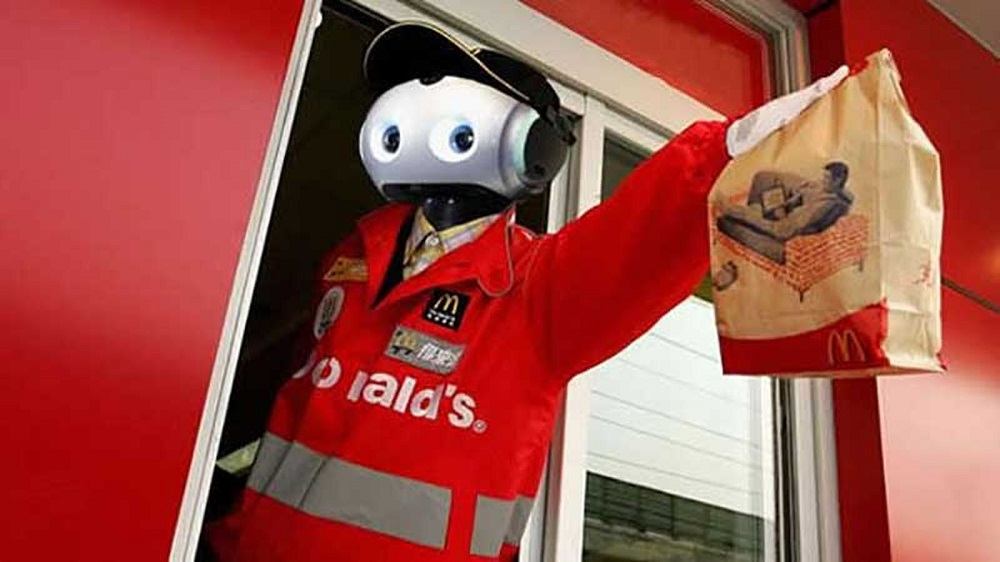
One end-of-the-world scenario is the robopocalypse where intelligent robots take over the world either by wiping out the human race or enslaving them. Two very popular franchises that tackle that scenario is the Terminator franchise and The Matrix. But the human race is very much aware of such scenarios through the aforementioned and other sci-fi tropes enough to prevent such by hopefully putting safeguards in the AI built into current robots, especially the lethal drones rumored being built. But there is another scenario wherein robots could take over simple jobs, leaving the less-educated or menial workers jobless, which isn’t much better. For many people, losing their job means the end of the world.
“Studies have suggested that a third of jobs in Europe will be replaced by technology over the next two decades.”
— Lynda Gratton, Professor of Management Practice, London Business School
Already some of these robotic workers are serving drinks in bars and receiving guests in Japanese hotels. For some time now, robots are the main workforce in automotive assembly lines. Dominoes in Australia already has a robot pizza delivery service, and Amazon is working on delivering packages via drones. But robotics technology may already have reached the level wherein robots are smart enough to serve as waiters and cashiers at your local fast food chains such as McDonalds. It seems inhumane depriving minimum-wage earners one job option, even if it’s flipping burgers or waiting tables but businesses still have to worry about the bottom line as well as lessening the stressful, headache-inducing worker relations and labor laws.
That’s right. No more whiners, no more clock watchers, no more vacations, no more sick leaves, no more day offs, no more worker insurance. The list could go on but what’s best is, no more minimum wage. Robots can work all-day long, seven days a week, stay friendly with customers and never complain about wages. It shouldn’t be a difficult task for a robot at McDonalds to take customer orders if it can recognize languages, accents and speech patterns. Theoretically, there would be less mistakes on orders. Customers would be assigned tables, and robotic waiters can deliver the orders. It’s a very expensive setup at the beginning but for food chains that are often packed like McDonalds, the returns can be substantial in the long run.
“I was at the National Restaurant Show yesterday and if you look at the robotic devices that are coming into the restaurant industry… It’s cheaper to buy a $35,000 robotic arm than it is to hire an employee who is inefficient making $15 an hour bagging French fries…It’s not just going to be in the fast food business. Franchising is the best business model in the United States. It’s dependent on people that have low job skills that have to grow. Well if you can’t get people a reasonable wage, you’re going to get machines to do the work. It’s just common sense. It’s going to happen whether you like it or not. And the more you push this it’s going to happen faster.”
— Ed Rensi, Former CEO, McDonalds
It sounds really grim for minimum-wage workers or part-time students looking to pay their student loans or supporting themselves. Such a statement is also a blow for public relations as a company like McDonalds cannot afford to alienate customers by being anti-labor.
“The suggestion that McDonald’s is planning to replace employees with robots is completely untrue. Our staff are vital to our business and in the UK alone we employ over 110,000 people who serve 3.7m customers every day.”
— Spokesman, McDonalds UK— Spokesman, McDonalds UK
Unfortunately, the electronics and automotive industries aren’t just as transparent. Unlike fast food chains, most people don’t get to see what happens inside closed factories. Foxconn, a major electronics supplier for Samsung and Apple just reported replacing 60,000 factory workers with robots. In countries like China where the bottom line is much more important than worker welfare, they will implement robotics wherever they can to cut costs but, hopefully, improve quality unless that doesn’t matter either. But of course, they need to soften the blow…
“We are applying robotics engineering and other innovative manufacturing technologies to replace repetitive tasks previously done by employees, and through training, also enable our employees to focus on higher value-added elements in the manufacturing process, such as research and development, process control and quality control. We will continue to harness automation and manpower in our manufacturing operations, and we expect to maintain our significant workforce in China.”
— Foxconn — Foxconn
Their solution is to shift worker focus from simpler jobs to complex ones as suggested by Professor Gratton:
“…As middle-skilled roles disappear, workers may find that the ‘rung’ above them no longer exists, and that the career ladder may begin to look more like a career web. The ultimate implication is that workers cannot now expect to gain seniority by moving ‘up’, but rather moving sideways by gaining additional complex skills.”
Which is the only real way to go for the human race or any progressive nation that implements a robotic labor program. Humans must learn more complex jobs if they want to stay ahead of robots that become more and more complex. Humans have no problems learning complex skills. The problem is, how many jobs are there? Anyone can get a job as a garbage collector. If that profession gets taken over by robots, how many openings will there be for garbage compactor operators?
Sad to say but the labor-robopocalypse may soon be upon us. The only things that can keep it at bay would be a fixed income scheme wherein every able-bodied adult is paid a fixed income, free education, limited autonomous labor legislation or some new industry similar to business process outsourcing and app development.

